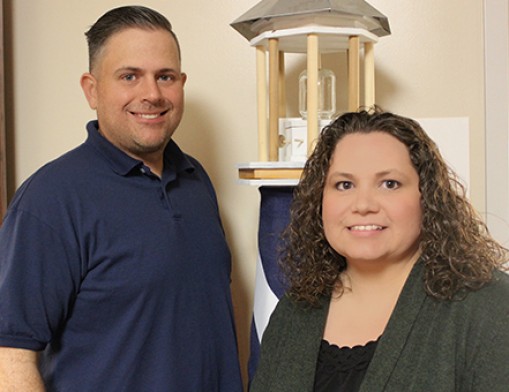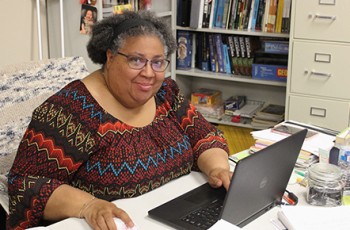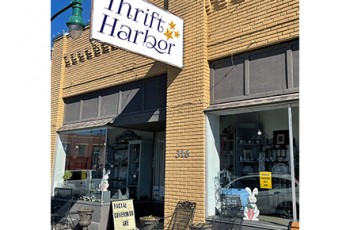
By definition, a harbor is a place where vessels may go to find shelter from the rough waters.
Nestled in rural northern Claremore, Hope Harbor serves just such a purpose, helping families to find shelter from the sometimes rough waters of life, to heal, and to move forward from trauma or other difficulties.
Among those who help facilitate that recovery are Dirk O’Donnell and Stephanie Steward.
“Hope Harbor is a place that gives families a chance to heal,” said O’Donnell, Hope Harbor executive director. “Our main focus is to help families who apply for their child to come here because life at home with that child or life at school has gotten to the point that the parents aren’t sure what to do with them. One of the biggest things, from my perspective, is people who partner with us – either financially, or through thoughts and prayers – they’re providing a path forward to families that are really at the breaking point.
“Something I talk about quite a bit is our partners and donors providing the tools and support for these kids to move forward in life,” he continued. “One example of this would be our nine step program, which both the kids and the families work through while the child lives here on campus. It helps establish for the children a foundation of respect – respect for themselves, respect for others and respect for the environment, the area that’s around them.”

Students who participate in the program live on the Hope Harbor campus, from nine months to a couple of years, depending upon their need and rate of healing. While on campus, they receive an education from certified instructors at the institute, while living on-site in the cottages, giving them a sense of home stability and purpose, as they continue their education.
“Meanwhile, the parents have a similar program that they’re going through at home, and at least once a month, are here on campus to undergo counseling with the kids,” he said. “Oftentimes, they might have a couple of sessions a month, depending on where they are in the program. The kids also have weekly counseling on their own – that’s the support aspect of it. As far as the tools aspect goes that could include the education they receive at our academy, or while living at the cottages and learning responsibility through chores, taking care of themselves, learning proper boundaries and respect for those around them.”
A large part of both the academic and living aspects of Hope Harbor involve instilling confidence and self-worth in the students, as many come from backgrounds involving trauma.
“Hope Harbor provides a kind of test environment for kids to safely learn how to deal with the effects of their past experiences, which are often the root of their struggles, and handle them in a productive rather than a negative way so that they can handle the challenges that face them when they move forward in life,” he said.
Hope Harbor is capable of handling children from grades 7-12, even being set up to take 18 year olds in and helping them through their mid-20s, depending upon the situation.
Hope Harbor’s academy is fully licensed, with certified instructors teaching according to Oklahoma education standards, meeting the students at their level and allowing them to stay on par with their academic work for their entire time at the institution.
The campuses at which the children live, currently, three in all – have house parents to monitor and care for the up-to-6 children per cottage.

“Our house parents live with the kids and essentially do everything their own parents would while there,” said Steward, Hope Harbor marketing director. “We wanted the cottages to be as much like a home environment as possible, rather than like a dorm or institution. They do family-style meals, which the students help in the cooking and cleaning, they hang out in the living room, they play games, enjoy limited TV time, paint, etc. We really do what we can to make it as much like home and a positive environment as we can.”
Utilizing a trust-based relationship intervention, Hope Harbor staff invest themselves in the young people, letting them know that they’re not on their own.
“Our clinical director Jennifer Bristow Cain handles the counseling, which is at least 30 minutes to an hour each week, group counseling once a week, and counseling with their families, at least once a month,” Steward said.
Over the course of their time with Hope Harbor, the students are allowed passes to return home and implement their newly-learned strategies and discipline with their families.
“It’s interesting that you get to see the children looking forward to spending time at home with their parents again,” O’Donnell said. “What starts out as two sides in opposition with one another, by the end of the program, you see the child working to get back home and to have time to reconnect with their families, and that’s an amazing thing to see.”
Hope Harbor accepts applications from across Oklahoma, so long as the parents are able to make it to in-person counseling sessions.
“We do several fundraising events every year, and we currently have our clay shoot coming up at Snake Creek Shooting Sports in Beggs,” Steward said. “Our website has an events page which stays up to date with our fundraisers – including the one in Beggs – but we also have a thrift store in Claremore called Thrift Harbor, the sale of items from which helps us, and of course, we also take donations, which are greatly appreciated.”
Steward, who actually served for five years as a house parent before she became marketing director, said she always enjoys seeing the transformation of the children, the healing and encouragement they gain during their time at Hope Harbor, and watching them to go on to become confident adults.
Tax-deductible donations may be sent by mail to: Hope Harbor, P.O. Box 1047, Claremore, OK, 74018.
For more information about Hope Harbor, call 918-343-0003 or email eat0@eau0eav0eaw0.
https://www.valuenews.com/a-path-for-families-at-their-breaking-point-news-article_5447

